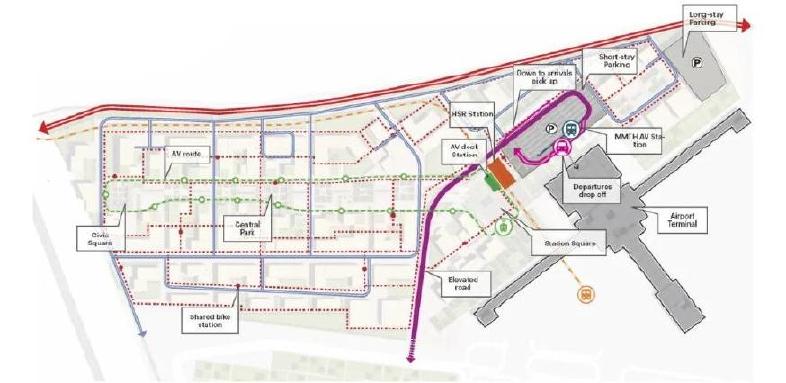The past decade has been a decade of transformation and development in the aviation industry. The enormous changes in environment, technology, and social demands are forcing operators and designers to fundamentally rethink the future operation of airports..

KPF’s airport design practices are unique among peers. We will not undertake a large number of aviation design projects, but provide customized services based on the size and geographical location of the projects. We have formed a professional team worldwide to provide services, including airport planners, designers, comprehensive development, and commercial design professionals..

The structural framework of the arch of Terminal A at Zayed International Airport.

Zayed International Airport – Airside Outer Facade of Terminal A.

We are more focused on projects that truly have influence and drive airport design changes, such as Zayed International Airport – Terminal A, Singapore Changi Airport Terminal 5, and Matsushima near Incheon Airport – one of the most successful aviation cities in the world. However, we will also design some smaller projects that serve as regional gateways in long-term planning..

We conduct airport planning in a systematic manner, formulate strategies for the effective development of the airport, maintain consistency with local and international regulations, and meet customer goals. One of the main goals of airport planning is to ensure the effective utilization of airport resources and meet the needs of relevant stakeholders, while considering environmental and financial feasibility..

Nowadays, aviation related buildings play multiple roles in airport developers, operators, local and international communities. To provide services to passengers, employees, enterprises, operators, transportation and trade, and related stakeholders in multiple fields..

We have rich experience in aviation related planning and can meet the requirements of project design, including international gateway airports, regional airports, and airport related facilities, to help the airport community operate more efficiently. Our approach combines technical and operational expertise, integrating a deep understanding of passengers and system processes, with a focus on quality, to create an excellent passenger experience..

U-Tapao Airport Urban Departure Level Planning (Upper) and Arrival Level Planning (Lower)..

Any airport design must obtain approval from stakeholders and regulatory agencies. At the project site, we actively engage in dialogue with major stakeholders and all relevant departments (mainly the construction, fire, and transportation departments), and provide our proposed design solutions to the authorities from the very beginning. This strategy enables us to respond promptly when encountering resistance in design proposals, or to provide support to stakeholders and authorities in the decision-making process by benchmarking with other aviation projects that can be referenced in the region and globally..

Cuplock Scaffolding Components

In our airport planning method, we prioritize planning at two different scales, namely the macro scale of the airport in the city and the micro scale of the airport as the city itself..

In our project, a consensus is to blur the boundary between the airport and the surrounding environment. To achieve this goal, the terminal will be integrated with the surrounding areas, guiding people to expand their activities beyond the terminal. This makes the airport portal a true component of its environment and a natural extension of adjacent urban structures.








